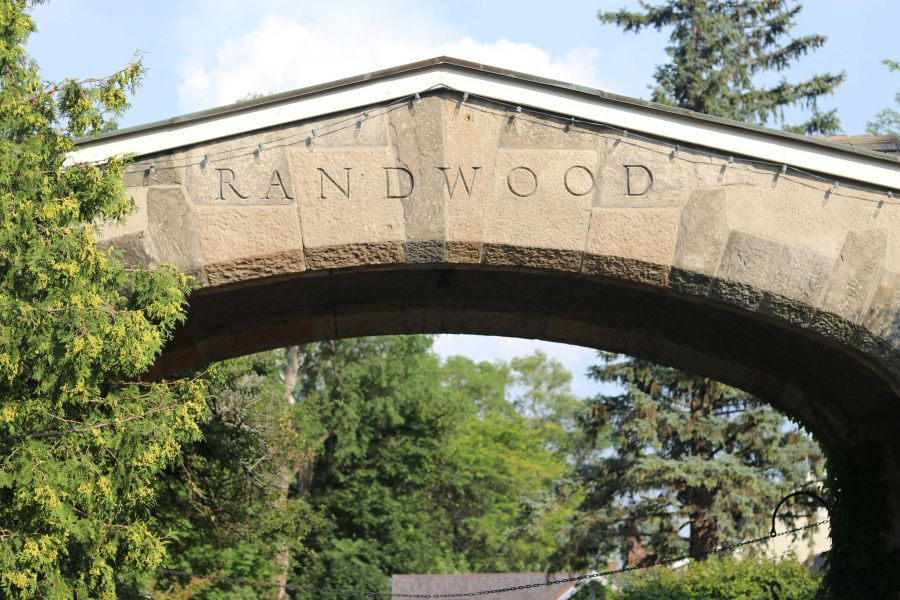This story is one in a series about the history of the Rand Estate, about 35 acres of land lying behind the stone wall on John and Charlotte streets, along the Upper Canada Heritage Trail and whose eastern boundary is a hedge between the properties at 176 and 210 John St.
Elizabeth Masson
Special to The Lake Report
George Rand II (1891-1942) followed in his father’s footsteps and became a banker.
He began working at the Marine Trust Co. in 1916. After a number of mergers, by 1929, it had become the Marine Midland Corporation with branches across New York state and Rand serving as president.
In 1922, he married Isabel Williams. They had three children: George III, Isabel and Calvin. The elder Rands were frequently seen in town in their Pierce-Arrow cars (which were manufactured in Buffalo); Mrs. Rand’s caramel-coloured car had her initials engraved on it. Older residents of town also remember the Rands for their lavish fireworks display on the Fourth of July.
Shortly after George Rand’s wedding, his sister Isabel married Col. Henry Sheets. Rand’s wedding present to them was a house built at the former Rowanwood location near the corner of John and Charlotte streets.
This white frame house was built in the Colonial Revival style, an architectural style which had become popular following the Philadelphia Centennial exhibition in 1876 although the greatest number of houses in that style were built in the 1910-30 period. While it was primarily based on the symmetrical Georgian style, it was often mixed with various other English house styles.
The Sheets House has a large front verandah whose roof serves as a balcony; both are surrounded by Chippendale-style railings.
A loggia on one side of the house is balanced by a conservatory on the other, maintaining its symmetrical appearance. Three dormer windows have been placed in the roof. The main rooms in the interior all have classical fireplaces and the dining room is decorated with well-preserved wallpaper depicting a garden scene.
It is not known precisely when the foremost landscape architecture firm in Ontario, the husband-wife team Dunington-Grubb, were hired to work on Randwood but it is likely to have been in 1919, shortly before George Rand I’s death.
The earliest of the sketches or blueprints pertaining to Randwood in the Dunington-Grubb Collection at the University of Guelph archives is dated 1928. But there are many undated documents which, as shown in photos of the grounds, had been built well before 1928.
Lorrie Dunington (1877-1945), after studying garden design for two years at a horticultural college in England, decided she wanted to be a landscape architect, a profession for which there was no formal training at the time.
However, she gained the necessary knowledge through private lessons and technical courses, eventually opening an office in London. It was very successful.
In 1910, she met another landscape architect named Howard Grubb. They married the next year and decided to combine their last names, being known as Lorrie and Howard Dunington-Grubb.
The Dunington-Grubbs moved to Toronto in 1911 and immediately became busy with commissions for new homes there. Two years later, they founded Sheridan Nurseries https://sheridannurseries.com/about/company-history/ outside Oakville on 100 acres of land. By 1926, it had grown to 250 acres and had a wide range of trees and perennials.
They were known for incorporating the work of well-known sculptors into their garden designs. Eventually, the Dunington-Grubbs were to design many acclaimed gardens in the Toronto-Niagara area, including the one at the Old Mill Tea Room, those at the entrance to McMaster University, the Rainbow Bridge Gardens and Oakes Garden Theatre in Niagara Falls, as well as the grounds at Parkwood in Oshawa, home to Samuel McLaughlin, the founder of General Motors Canada.
The work at Randwood includes the magnificent central axis which leads from the main wrought-iron gate on John Street to the front door of the house.
A long, cut-stone path leads to a small set of stairs that descend to an oval pond in the centre of which is a small statue, about a metre high. The statue is that of a girl sitting on a stone pillar facing the house.
One Mile Creek, which meanders across the Rand Estate grounds and eventually empties into Lake Ontario, appears to flow through the pond although it is actually diverted slightly below it.
The central walkway, after being interrupted by the pond, then ascends some stairs and ends at the porch in front of Randwood.
Many of the Dunington-Grubbs’ designs were situated behind the house. The swimming pool, 20 feet wide and 60 feet long, was the first one to be built in Niagara-on-the-Lake. Next to it, was placed a pool pavilion with a shingled roof, held up by pillars.
Nearby, a small white building in the shape of a Greek temple was situated; it is sometimes referred to as a tea house and at other times as a bathhouse.
According to an article in a “Canadian Homes and Gardens” magazine in 1930, a pergola covered with pink rambling roses served as the entrance to the garden area composed of miniature flower beds.
A list of perennials that the Dunington-Grubbs used in their gardens is voluminous including yarrow, anemone, alyssum, bellflower, bleeding heart, candytuft, maltese cross, iris, phlox, and many others.
Two other structures whose design is not attributed to the Dunington-Grubbs were built near the swimming pool when George Rand II owned Randwood.
The guest house was damaged by a fire in the 1970s; it is now a storey-and-a-half stucco building with an irregular roof design. Next door to it is a two-storey stucco garage; the upper story has accommodation, which the chauffeur could have used.
The wooden doors on the ground level through which automobiles would have entered have diamond-shaped windows.
Not far from the garage is a building known as the Coach House. Likely constructed by the Dicksons in the Gothic Revival style, it has a steep gable roof with decorative trim attached. The door and windows are surmounted by elliptical arches.
Because of George Rand II’s interest in farming, a second barn was built in 1936. One storey high and U-shaped in design, it is similar to the other outbuildings on the Rand Estate in that it is made of stucco and has diamond-paned windows.
It was placed on the southern edge of the estate, not far from the wall along the railroad tracks.
George Rand II died in 1942 at the age of 51; his wife Isabel continued to spend summers at Randwood until her death in 1950. Their three children, George Rand III, Isabel and Calvin inherited Randwood.
* Elizabeth (Betsy) Masson has been a research volunteer at the Niagara-on-the-lake Museum for more than 15 years.









